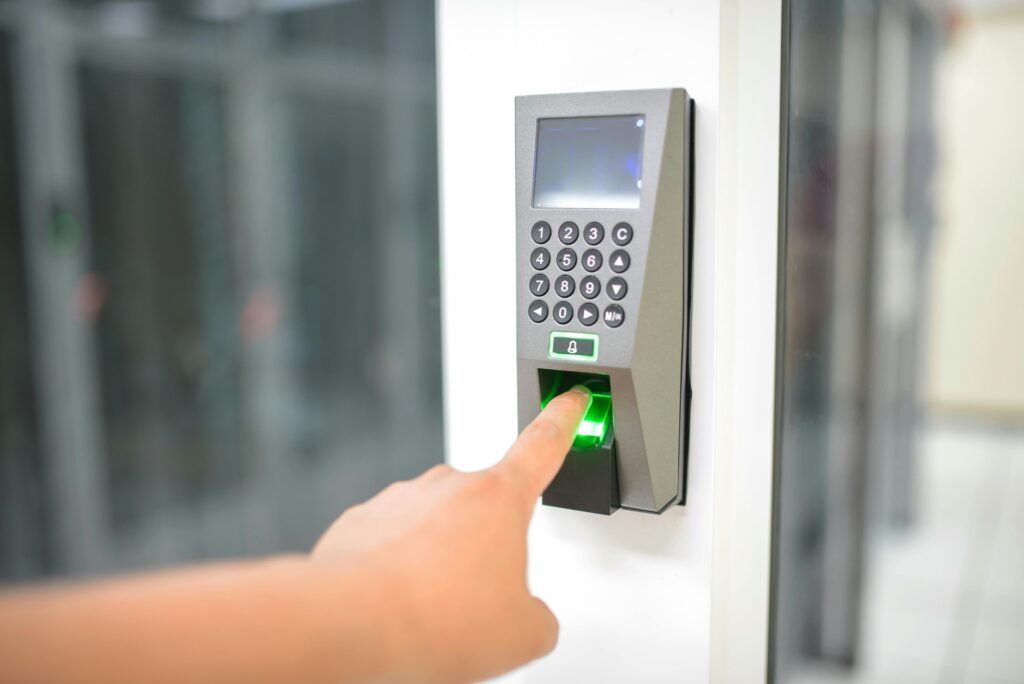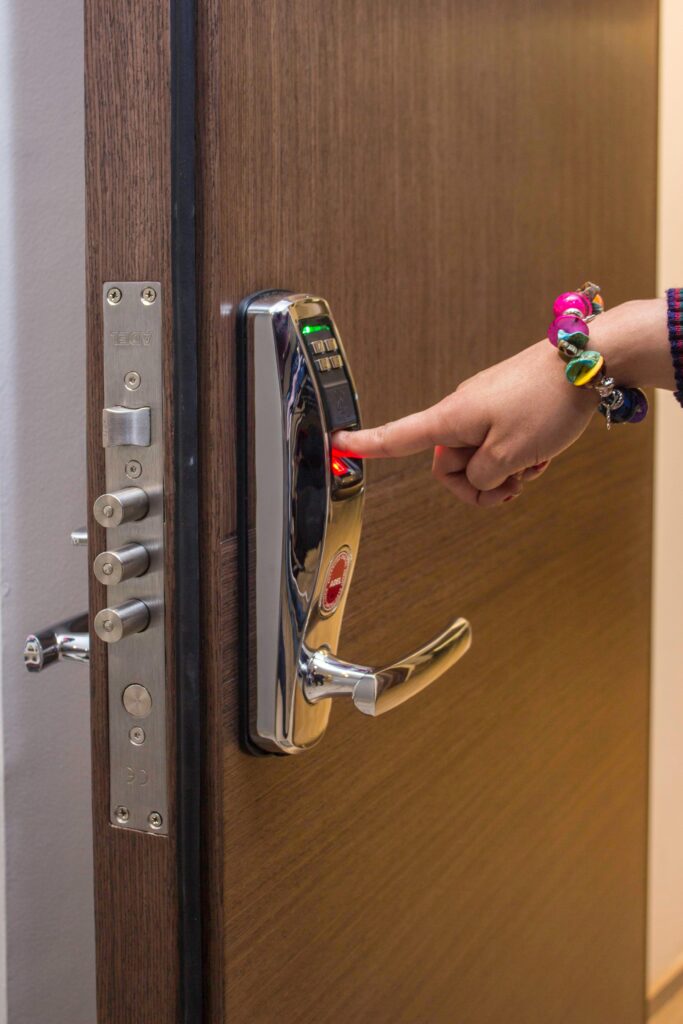
Table of Contents
Toggle1. Introduction
Just imagine a situation where you are just returning from the office and you are exhausted. When you are about to open your home doors, you notice that you have missed the key somewhere. The spare key was with your wife; she is also out of station. What happens if the key is passed to the wrong person? You feel terrible, don’t you?. We know the traditional keys come with security risks.
But the modern techno world gives a solution. What if I say your finger is your door key? Shocking! But yes, it is the technology of fingerprint locks. Using these locks, there is no tension of losing a key. The lock is designed in a sleek and cute way.
In this article, we tried to explore the technology and explain to you about this system. Like, how the system works. What technology works, what are the types of sensors, etc.? By the end, you will know how to decide whether you need this system or not.
2. What is a Finger Print Lock?
On using traditional keys, you have to safeguard them always. In number lock systems, you should remember the “code number always”. In other cases, you have to carry the swipe card and safeguard it.
A fingerprint lock is a locking device that allows you to enter your home with your unique fingerprint identification. It works on biometric technology.
Biometrics is a technology that scans and keeps your physical or behavioral characteristics, like eyes, fingers, face, voice, etc., as identification.
Remember, your finger is a unique identification of you. It remains unique even if you are twins.
The working is simple, keep your finger, the machine scans and registers your finger print in the memory. Then you will become the authority. All the actions will be carried out only by you as a registered No one else can enter the system.
3. The magic behind the locking system
3.1 Enrollment
The process of giving identification to a person in the beginning is called enrollment. During the enrollment process, you just need to place your fingers on the sensor multiple times, in different positions. The machine scans your finger in all directions and angles, and it differentiates between fingerprint ridges and valleys and stores the data.
The fingerprint will not be saved as an image. But it finely analyzes the ridges, valleys, curves, and the distance between ridges. And finally, digitize the data and store it in the lock’s memory in an encrypted form.
Here, note that your fingerprint is not stored as an image. It is stored in a different manner that could not be reproduced.
3.2 Recognition
Once enrolled, the lock stores the person’s fingerprint. After proper installation, when the person places the finger on the sensor, it immediately scans the finger and sends the data to the next stage for comparison.
3.3 Comparison
When the signal comes from the sensor, the system compares the received data with the authorized data that is stored. If they match, it sends a positive signal to action.
3.4 Action
4. Sensors
The real development of fingerprint locks lies in the sensor technology. There are a few types of sensors available in the market. Each sensor has its way of sensing objects. Let’s explore a few used in fingerprint locks.
4.1 Optical Sensors
These sensors use old technology. The light illuminates the
finger surface, a power captures the image in a 2D form, and the digital image
is stored for lateral comparison.
Pros: It is cheap and widely used.
Cons: If dirt or any oily substance is on the surface, the quality will be poor. Not suitable for high-end security applications.
4.2 Capacitive Sensors
These types of sensors are much smarter. They use small electrical currents. Your ridges and valleys might have different currents. It senses the body current flowing on your finger surface, recognizes the variations in the currents, makes an electrical map, and reproduces your unique fingerprint in digital form.
Pros: It is far better compared to optical sensors. Since it works by recognizing body currents, physical touch of the finger is necessary. You cannot fool this sensor by keeping fake finger models. They are faster and more accurate compared to optical sensors.
Cons: Since water conducts electricity, if somebody touches the sensor, it is difficult to reproduce the fingerprint, as the wet portion may interfere with sensing. So, too wet and too dry fingers may cause problems. These types of sensors are mostly being used in mobile phones and some mid-level security locks.
4.3 Ultrasonic sensors
Ultrasonic sensors are the latest on the market and use cutting-edge technology. For sensing, it emits high-frequency waves on your finger, and the waves will bounce back differently from ridges and valleys. Even small spores under the skin have also been identified. With the bounced-back waves, the system accurately reproduces your unique fingerprint in a 3D form.
Pros: This 2025’s advanced system. Since it uses a 3D image, it can’t be fooled by a flat 2D pattern. Since it uses direct waves, it doesn’t care about oily, dusty, dry, or wet fingers. It can even penetrate into the skin and get details underneath.
Cons: At present, the big disadvantage is cost. It is more expensive at this moment. Sometimes it is noticed more slowly by the capacitive sensors. But advancements are going on with this technology in 2025, and soon we can expect it at a good price.
4.4 Liveliness detection
No matter what type of sensor is being used, the system uses AI technology to detect the liveliness of fingers, like skin temperature, blood flow rates, small shaking or movement in the finger. Using this data, the system easily detects whether the placed one is a real human finger or a fake. In this way, the system is more intelligent and nobody can fool it.

DIY Projects on Home security
5. Beyond fingerprints—Extra security and Smart Features
We all know that fingerprint locks give access through your fingers. But is it only that? No, it supports some additional security and smart features too. The present-day locks go beyond reading your fingerprints. Let’s explore a few
5.1 Multiple unlocking methods
PIN codes: You can easily temporarily create PIN codes for guests, family members, cleaners, etc. You can erase it after use.
RFID cards: RFID cards are small and convenient to use with the device. It is ideal for children
Traditional keys: There is one keyhole present to use traditional keys. This may be useful during power failures.
Mobile app (via Bluetooth/Wi-Fi): Here is where the real smart comes in. You can unlock the door remotely from anywhere with a smartphone.
Connecting to smart home hub: The latest lock systems can connect to popular platforms like Google Home, Amazon, Apple HomeKit, Alexa, etc. It can understand voice commands also
5.2 Automated Actions
You can make the following things automatic:
- If you open the door with a fingerprint, we can immediately turn the hall lights ON.
- You can disarm your security alarm when you enter.
- When you enter, you can set your thermostat to your desired temperature.
- You can even make your blinds open or close automatically when you enter.
- Lorem ipsum dolor sit amet, consectetur adipiscing elit. Ut elit tellus, luctus nec ullamcorper mattis, pulvinar dapibus leo.
6. Fingerprint door locks - Right Choice? Or Not?
Fingerprint door locks are a modern, convenient, and secure alternative to traditional locks. The fingerprint locks have their own advantages and disadvantages. Before deciding to switch over, it is better to know the advantages and disadvantages of the lock.
Let’s explore the pros and cons.
Pros
Convenience: No headache of carrying keys with us all the time.
Easy access: No need to struggle with keys to open; just a finger touch is sufficient.
No more lost keys: In traditional locking systems, there is always a chance of losing the keys, but here there is no problem at all.
Smart Features: Controlling with smartphone, remote controls, automation features, activity logs, etc.
Modern design: Sleek and good-looking, the technical design will surely attract you.
Cons
Higher Cost: Unlike traditional locks, the initial cost is higher.
Electricity Power: Always needs electric power to run. In case of power failures, a battery or any other kind of power backup is necessary.
Weather problems: Some sensors may become defective due to rain or dust, especially when they are installed outside.
Privacy: The system works with biometric technology. The data should be secured to avoid risk.
Complexity in Setup: It is not as easy as a traditional setup. The initial setup requires knowledge and technical expertise to properly set up.
7. Conclusion
Surely the fingerprint lockers will eliminate the hassles of a traditional locking system. It offers excellent security; it won’t allow any unauthorized entries. It has so many advantages over traditional keys.
If you are a person concerned more about speed, updated technology, and exploring smart features, then you can go for the fingerprint locking system.
But if you are a person concerned about power stability, prefer simplicity, or don’t like too much technical.
Then, consider your lifestyle, budget, and security needs before making decisions.

